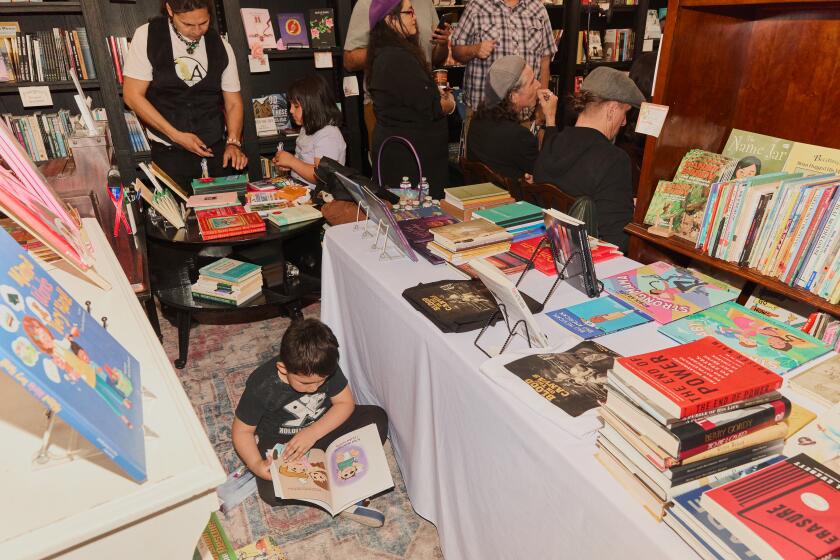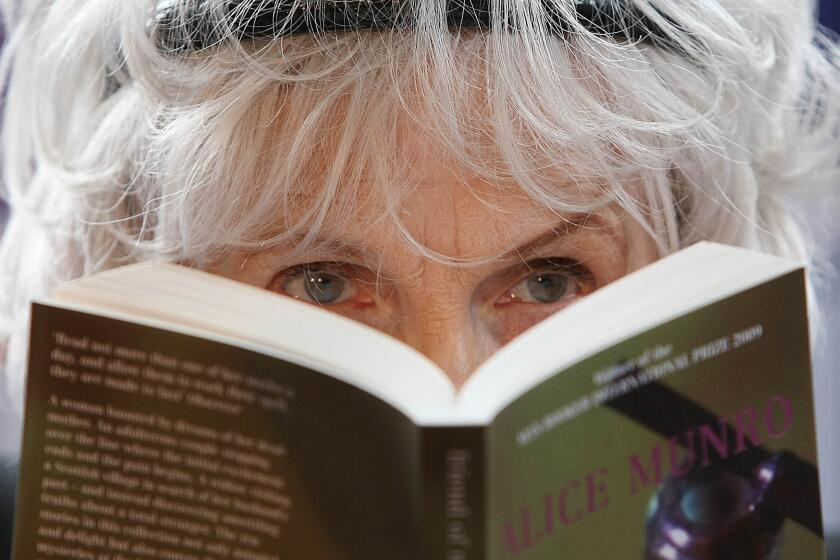A past tense
One might be tempted to ask Jonathan Lethem if those indeed are X-ray specs he keeps pressing close against the bridge of his nose. Perhaps that’s because Lethem doesn’t appear to see what a mere out-of-towner -- or, for that matter, any mere mortal -- might first take in.
On this requisitely scruffy-at-the-edges (and thereby certifiably hip) stretch of Court Street, Lethem takes a sentimental afternoon stroll. Hands jammed into the pockets of his cuffed blue jeans, his suede retro sneaks slapping out a quick pace, the novelist surveys the comings and goings of his most recent muse: his old neighborhood.
The slurring cacophony of car horns, the squiggly trip-hop tumbling out of Jordan almond-toned storefronts, the accented conversations shouted from opposing corners. Lethem doesn’t quite see this present without seeing the past peeking out from the edges, “bleeding through.”
In a New York minute it’s clear. It isn’t X-ray vision of the comic book superhero variety. It’s Lethem’s persistence of vision, his fixation with old -- now phantom -- Brooklyn and its lingering after-image. The one that informs his new, sprawling novel, “The Fortress of Solitude” (Doubleday).
“That’s the old Rex Theater where I’d go see kung fu and Charles Bronson movies,” he exclaims, nodding toward what is now a multiplex. Over here, a few blocks up Smith Street, stands the brightly hued Cafe Lulu; across the street is a Pan-Asian restaurant with a basement nightclub set awkwardly between old neighborhood fixtures, a furniture store and a bedding store. “All this used to be poor and bombed out ... now you can see the trajectory.”
Onward, the crush of curtained ristorantes, wine bars, boutiques selling tiny Ts with “brklyn” emblazoned across the front barely register. Nor does the corner corporate coffeehouse and the yuppie dad, in his “indoor voice” imploring his screaming toddler to “use words.” It all skids past him; fails to come in crisp focus.
“When Manhattan gentrifies, it’s total,” Lethem says. “In Brooklyn, it’s much more awkward. More fitful. The old one bleeds up,” he says with a satisfied smile. “I walk down the street and I see what’s changed, but I also see big chunks of 1972.”
“The Fortress of Solitude” is set squarely within this strictly bordered multiracial-multiethnic neighborhood that Lethem has known intimately for more than 30 years: the shortcuts to best avoid a butt-kicking; the best slate on which to sketch out a board for a game of skully; the farthest spot on the block where you’ll still be able to hear your parents call you home.
It is the story of two best friends, Dylan and Mingus, one white, the other black, and the territories they traverse over the years -- together and apart, physical and psychological, real and imagined.
It’s a page -- or rather 500 -- from Lethem’s own life. At least sort of.
He calls the book “spiritually autobiographical,” the result of merging the anecdotes of a dozen friends and recollections from his younger brother and sister. “I borrowed a lot of their tales, their souls.”
There was something about that moment in history, recalls Lethem, that post-civil rights movement window in the early 1970s. “So much succeeded and so much failed in that unfinished revolution of the ‘60s. My family was idealistic,” he says. “We moved to a neighborhood where whites were in the minority, kinda proudly.... So I didn’t know how to come home and say, ‘Well, Dad, actually, I’m being told I’m white all the time.’ I wasn’t the only one having strong feelings. [There] was a lot of wrestling over identity and class. But for the life of me, I didn’t know how to put words to that.”
Walking the neighborhood
The novel is as much about coming of age and finding one’s voice as it is about race and class and the middle spaces so many ultimately inhabit. It is about the frame-by-frame process of evolution of a neighborhood. About confusion and isolation, language and the frustrations of not having it. Like graffiti thrown up, blooming in darkness, it is about becoming visible.
The blessing, however, for all of its big themes (and all the talk surrounding this as Lethem’s “Big Book”), is that “The Fortress of Solitude” doesn’t go down as strong medicine. It is not a weighty “race book” nor full of “voice-of-a-generation” affectation. Its girding is in Lethem’s clarity of vision and his intimacy.
All of it is set against an evocative swirl: Pro-Keds and Pumas; wild-style graffiti and “Rapper’s Delight”; Rufus and the Jackson 5; Kurt Vonnegut and Richard Brautigan; comic books and “Star Trek.” It’s a boy’s life -- of superhero flights of fantasy as a means to cope with frustration and insecurity.
We slip down Butler toward what used to be Lethem’s neighborhood school, I.S. 293, where a large portion of the cross-racial tension in “Fortress” takes place. Behind the chain-link fence, on the wall of a littered handball court, a painted sign proclaims: “The School for International Studies.” The “International” has been lined out and over it is scrawled “Thug.”
The Gowanus Houses, the neighborhood housing project, is stacked up in the not-so-distance. The grounds at the moment are quiet, sparsely populated; the sun flirts back and forth under the clouds. Summer is just about a memory.
To begin to write this book was to begin Lethem’s journey back. In pieces. To rethink these streets. Their boundaries and zones.
This story -- the collective stories of Mingus and Dylan -- had long been tailing Lethem. He’d tried to duck out of it, just as he’d ducked out of Brooklyn, living for a time in Northern California, then Toronto.
Lethem, like Dylan, began to peel away from his past and what he couldn’t square about it. His attention turned to other things -- art, music, writing. He amassed a cult following with his earlier books, which have taken broad flights of fancy -- in noir and speculative and science fiction, sometimes all at once.
“I was much more concerned with place as concept,” he says.
Slowly, he began to make his first steps back to Brooklyn. The first evocation, “Motherless Brooklyn,” a wry and amped-up noir nod at the detective novel, whose protagonist is bedeviled by Tourette’s syndrome, won the 1999 National Book Critics Circle Award for fiction. It told him something -- some sort of boldfaced variation of “Write what you know.”
“In many ways, I’ve held this material at arm’s length,” says Lethem, who moved back to the neighborhood eight years ago. But no matter how much he wanted to submerge the past, it would surface -- a song, a scrap of voice would sail out of the radio and take him back.
“When I first got to college and I was listening to Al Green’s ‘Greatest Hits, Vol. 1,’ I was sort of embarrassed at how much that music meant to me. It didn’t have a place in my idea of who I was.”
But it was the crack in the door.
Lethem may have been physically removed from the neighborhood, but he was still tethered to it by relations. His father, until recently relocating to Maine, still filled his days here with projects and friends. His younger brother, Blake, made the rounds and, of course, there were his friends -- among them, Karl Rusnak and Dione Ruffin.
“They were all more engaged and entrenched. Connected. All threads that kept me involved,” says Lethem. “It was strange to me that there was an area I couldn’t speak of. I’d spent a lot of time pretending not to be a product of the place.”
To sort it all out, Lethem began gathering with his friends and family. It wasn’t as if his conversation with Brooklyn was an unfinished sentence, “it was a sentence un-begun.”
Rounding another corner, Lethem steps up Bergen Street, peeks between the iron latticework of a garden gate where Rusnak and Ruffin await him. They give him a head nod. It’s seldom that they get to spend time together as the inseparable unit that they became so long ago. The writing of this book pressed the issue of talking about the politics and passions that brought them together and ultimately swept them apart.
“We hadn’t been able to speak about it,” says Lethem. “This was a chance to share, to talk together about how this period shaped them.” How they saw themselves: black, white, male, female. Brooklynite. “It created a hunger to analyze.”
Lethem’s known Rusnak since he was 5. They were across-the-street neighbors. “It was almost like an arranged marriage. We were the only other white people on this part of the block,” says Rusnak. Ruffin moved in later with his dad.
“He was the only urban kid I knew who was a Boy Scout,” says Lethem.
“I was also the only black guy playing hockey,” Ruffin says.
They are surprised at how quickly the history came back to them, how the coexistence marked them. “In the beginning, the first pioneers were the artists,” says Rusnak. “They made the big step.”
But then the chichi markets replaced the bodegas. “It was OK for the artsy white people, but not OK for the greedy people,” says Ruffin.
“Then the Arabs supplanted the Dominicans,” says Rusnak.
“Then there comes the other angst ... ,” says Ruffin.
“Most of the people who grew up here can’t afford to live here now,” remarks Rusnak. “Jona stirred up all this stuff that I’d forgotten about.”
“Growing up in this neighborhood makes you a professor of race and class, and social history,” says Lethem.
The trio make their way down Dean, looking at the remnants of old graffiti tags. “Here it is,” announces Rusnak, spreading his arms as he turns onto Dean Street, the house where Lethem grew up, foliage-hugged, fronted by a whimsical red door. Next to it, says Ruffin, used to be “the worst house on the block.” Now a pristine white Range Rover is stowed in its pocket of a driveway.
Looking down this stretch of classic row houses beneath a leafy canopy of trees, it looks more like a perfect back-lot evocation of New York than a child’s daily gantlet. It is much smaller than a reader of “Fortress” might expect. Like a childhood memory, Lethem’s telling recasts it as a vast territory -- of roiling nerves, of contests of one-upmanship -- to be cautiously navigated. Later, it would be the drugs, the threats of violence.
“Clearly, I remember walking down this spot, 1976, and I’m walking home and these kids are chanting, ‘Play that funky music white boy’ and throwing karate kicks” at him, Rusnak says as they linger near the stoop before Lethem’s front door. “I remember the bottle caps spangling the street and collecting them as a little kid. The Puerto Rican men sitting on milk crates talking loudly in Spanish and drinking cans of beer outside the bodega next to Jonathan’s house.”
“So much of racial conversations now are clotted and choked,” says Lethem. “There is no language.” Growing up in that environment shifted him, broadened his frame of perspective. “The black kids and the white kids and the Puerto Rican kids played together. It was always really complex. Gentrification couldn’t alter this. It was already a place of contradictions.”
It was home to Native Americans, sailors. “I found out that Isaac Asimov lived on my block, and when Malcolm X’s family was put up in a safe house, it was on my block on Dean. These contradictions predate me. Predate all of us. This place was born to reflect New York’s paradoxical nature. There is an energy that comes from these juxtapositions.”
An organic pulse that’s difficult to still, to capture.
“By doing this, writing this book,” says Ruffin, “it concretes it.”
“The block,” says Rusnak with an approving nod, “has now been immortalized.”
The three of them settle onto a stoop, overlooking the quiet street and an abandoned hopscotch diagram. Women push strollers. A man makes his way down the sidewalk hawking VHS tapes out of a shopping bag. Their talk stills some. The light begins to leak out of the sky. They linger. Who knows for how long, since now there won’t be a parent’s call to corral them, to put hasty punctuation on an unfinished sentence.
More to Read
Sign up for our Book Club newsletter
Get the latest news, events and more from the Los Angeles Times Book Club, and help us get L.A. reading and talking.
You may occasionally receive promotional content from the Los Angeles Times.






